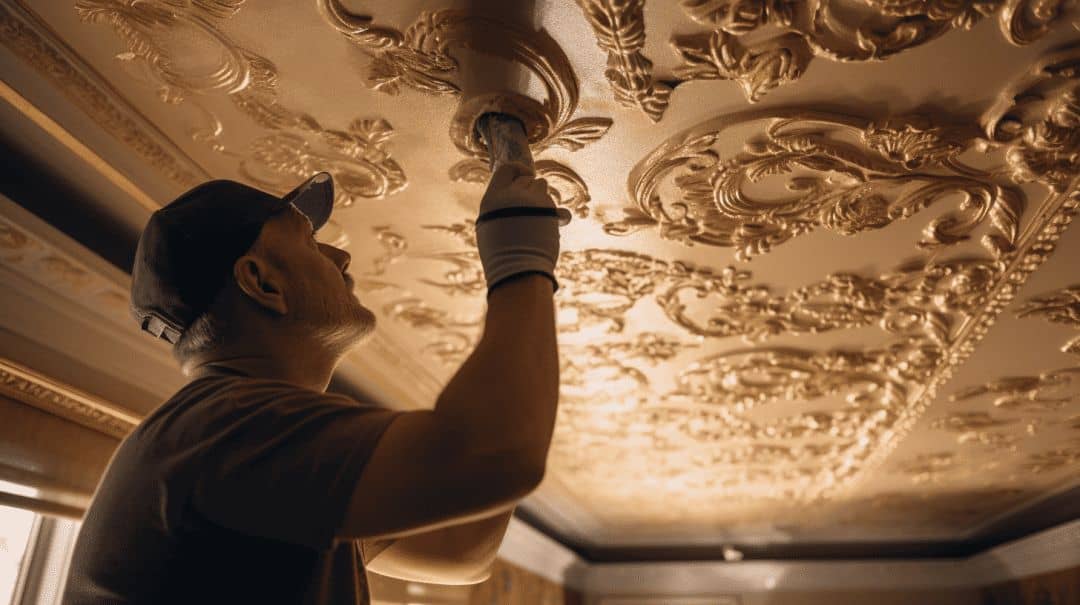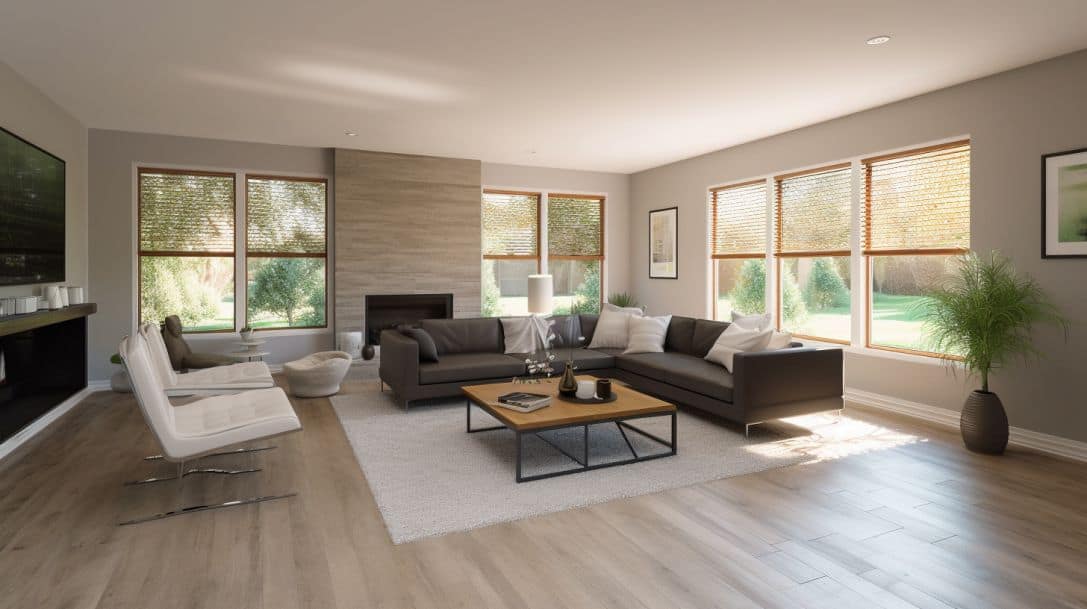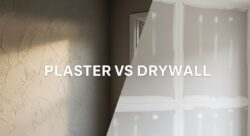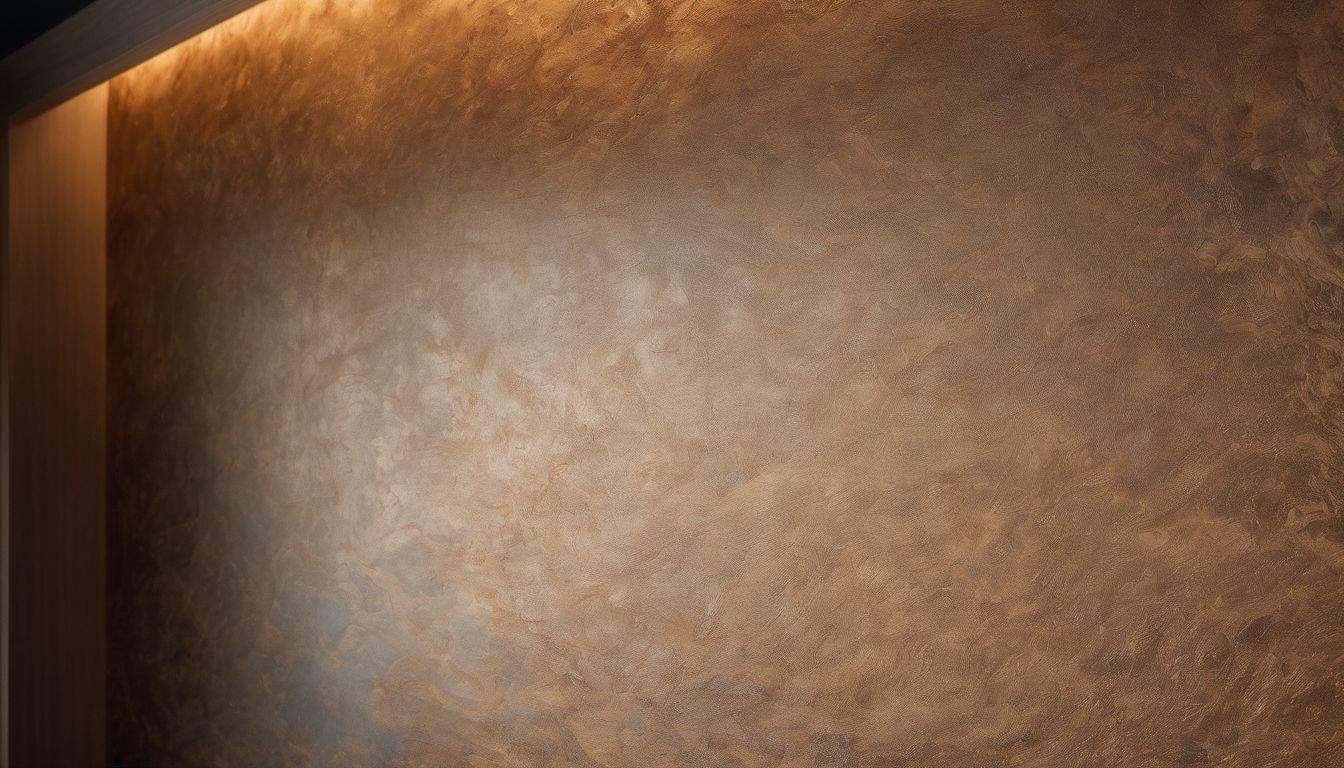Transforming Interiors with the Subtle Elegance of Plaster: A Modern Take on Minimalist Design Trends
Are you tired of plain walls in your home? Plaster designs are making a comeback in modern homes. This blog will show you how to use plaster to create a simple, stylish look. Get ready to transform your space with plaster!
Key Takeaways
- Plaster designs are making a comeback in modern homes, offering a simple and stylish look.
- Minimalist plaster designs focus on clean lines, smooth surfaces, and neutral colors like white, gray, and beige.
- Plaster is eco-friendly, made from natural materials like lime, sand, and water, and helps control indoor air quality.
- Venetian plaster, made from fired limestone and water, is a green choice for walls that’s free from harsh chemicals.
- New plaster materials and techniques make it stronger, more durable, and easier to apply, with options for custom designs and textures.
Understanding Minimalist Plaster Designs

Minimalist plaster designs blend simplicity with elegance. They create clean, smooth surfaces that bring calm to any room.
Definition and Principles of Minimalist Interior Design
Minimalist interior design strips away excess. It focuses on clean lines and open spaces. This style uses a few colors and simple shapes. The goal is to create a calm, uncluttered home.
Less is more. – Ludwig Mies van der Rohe
Key rules of minimalist design include using only what you need. Each item should have a purpose. Neutral colors like white, gray, and beige are common. Natural light plays a big role too.
The result is a space that feels peaceful and orderly.
Benefits of Minimalist Interior Design
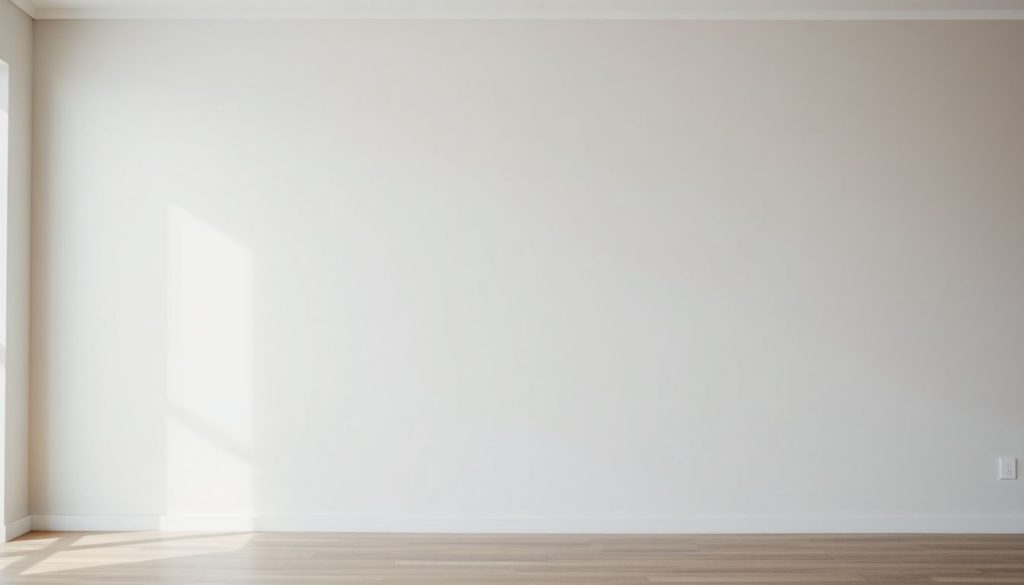
Minimalist interior design offers many perks for homeowners. It creates a calm and peaceful space by removing clutter. This design style uses fewer items, which makes cleaning and upkeep easier.
Rooms feel bigger and more open with less stuff around. Natural light shines better in a simple space, making it brighter and more cheerful.
This style also saves money in the long run. You buy less decor and furniture, cutting costs. The focus on quality over quantity means items last longer. Simple designs often use eco-friendly materials, which is good for the planet.
Plus, a clean look helps reduce stress and boosts mental health. Many find that a tidy home leads to a tidy mind.
The History and Resurgence of Plaster in Modern Interiors
Plaster has a rich history in interior design. It made a comeback in the 90s and has gained popularity for its eco-friendly nature.
The 90’s Resurgence
Plaster made a big comeback in the 1990s. Home decor trends from Tuscany, Italy sparked new interest in plaster walls and ceilings. People loved the warm, rustic look it gave their homes.
This trend brought plaster back into modern interiors after years of being out of style.
Homeowners started using plaster in creative ways during this time. They added texture to walls and made unique ceiling designs. The natural, earthy feel of plaster fit well with the casual style of 90s homes.
This revival set the stage for plaster’s ongoing popularity in interior design today.
Plaster as a Sustainable Choice
Plaster stands out as an eco-friendly choice for modern homes. It’s made from natural materials like lime, sand, and water. This mix creates a breathable surface that helps control indoor air quality.
Lime plaster, in particular, absorbs CO2 as it dries, making it carbon-neutral over time.
Clay plaster offers another green option for homeowners. It uses natural clay, sand, and pigments to create a unique finish. These materials are non-toxic and free from harmful chemicals.
Clay plaster also helps regulate humidity, creating a healthier living space.
Choosing plaster is like giving your home a breath of fresh air – it’s natural, sustainable, and beautiful all at once. – Eco-Design Expert
Key Features of Minimalist Plaster Designs
Minimalist plaster designs focus on clean lines and smooth surfaces. They create a calm, uncluttered look that’s perfect for modern homes.
Simplicity and Elegance
Plaster designs bring a clean, smooth look to homes. They create a blank canvas that lets other elements shine. Smooth walls and ceilings make rooms feel bigger and brighter. This style fits well with the “less is more” idea of minimalism.
Plaster adds a touch of class without being showy. Its soft, matte finish catches light in a gentle way. This creates a calm, peaceful feeling in any room. Many homeowners love how plaster can make even simple spaces feel special and refined.
Textured Surfaces and Neutral Colors
Plaster designs shine with textured surfaces and neutral colors. Rough or smooth finishes add depth to walls and ceilings. Earthy tones like Setting Plaster by Farrow & Ball create a cozy feel.
These soft hues reflect light well, making rooms seem bigger and brighter.
Neutral colors offer flexibility in decor. They pair nicely with bold accents or keep spaces calm. Fresh Plaster by Craig & Rose brings warmth inspired by natural lime. This trend moves away from dramatic colors to softer, more soothing shades.
Homeowners can easily change their look without repainting walls.
Exploring Different Applications of Plaster in Interiors
Plaster shines in many parts of a home. It adds beauty to walls and ceilings and makes unique furniture pieces.
Walls and Ceilings
Plaster shines on walls and ceilings in modern homes. It adds depth and style to any room. Smooth finishes create a sleek look, while textured surfaces bring warmth. Homeowners can choose from many options.
Raw plaster walls offer a rustic feel. Painted plaster gives a clean, polished appearance. For ceilings, plaster moldings add elegance without fuss.
Dulux Heritage paint works well on plaster. Start with Pale Nutmeg as a base coat. Then, apply Pale Walnut for a rich finish. This combo adds character to spaces. It’s perfect for those who want a timeless yet modern vibe.
Plaster is also eco-friendly. It’s free of harsh chemicals and VOCs, making it a safe choice for families.
Furniture and Decorative Elements
Plaster shines in modern furniture and decor. Sleek tables, chairs, and lamps made of plaster add a clean look to rooms. These pieces often have smooth curves or sharp angles. Plaster vases, bowls, and sculptures bring texture to shelves and counters.
Their neutral colors fit well with many styles.
Designers use plaster in creative ways for home accents. Wall sconces cast soft light and create shadows on textured surfaces. Plaster frames highlight art and mirrors with subtle elegance.
Even small items like bookends or candle holders can make a big impact. These elements blend form and function, making spaces feel calm and put together.
How Plaster Enhances Minimalist Interiors
Plaster walls and ceilings reflect light, making rooms feel brighter and more open. This natural glow creates a soft, welcoming atmosphere in minimalist spaces.
Amplifying Natural Light
Plaster walls boost natural light in homes. Their smooth surface bounces sunlight around rooms. This makes spaces feel bigger and brighter. Light colors like white or cream work best for this effect.
Floor-to-ceiling windows also help bring in more light. They connect indoor and outdoor spaces. Sheer fabrics on windows let in soft light. This creates a calm, modern feel in any room.
Light-colored plaster walls work well with these big windows.
Creating Seamless Transitions
Plaster designs create smooth shifts between spaces. They blend walls, ceilings, and floors into one flowing look. This makes rooms feel bigger and more open. Curved edges and soft lines add to this effect.
They remove harsh breaks that can make a space feel choppy.
Seamless transitions also help with light flow. Light bounces off smooth plaster surfaces, spreading evenly through a room. This creates a bright, airy feel that many homeowners love.
It’s a key part of the minimalist style that’s so popular now. The James Gorst Architects’ Sandpipers project shows this well. It uses white walls and polished concrete floors to create a clean, unified space.
The Role of Plaster in Interior Renovation and EIFS Possibilities
Plaster plays a key role in modern home updates. It offers a smooth, clean look that fits well with today’s styles. New tech has made plaster easier to work with, but it still takes skill to apply.
Most pros put on several layers, waiting about ten hours between each coat. This process adds depth and texture to walls.
EIFS, or Exterior Insulation and Finish Systems, brings new options to interior design. These systems do more than just look good – they also help with sound. EIFS can make rooms quieter by blocking outside noise.
While pricey, both plaster and EIFS can greatly improve a home’s feel and function.
Venetian Plaster: Eco-Friendly Wall Finish and Interior Projects
Venetian plaster offers a green choice for walls. This finish uses fired limestone and water, making it free from harsh chemicals. It’s safe for homes and kind to the earth. The plaster gives walls a soft, natural look that many people love.
You can pick from many colors by adding pigments to the mix.
Homeowners can use Venetian plaster in many ways. It works well on walls, ceilings, and even furniture. The finish is smooth and can look like polished stone. Unlike some paints, it doesn’t need extra stuff to change its texture.
This makes it simple and pure. Plus, it lasts a long time, so you won’t need to redo it often. That saves money and resources in the long run.
The Differences and Similarities Between Stucco and Plaster
Stucco and plaster are popular wall finishes. They share some traits but differ in key ways. Let’s break down their features:
| Feature | Stucco | Plaster |
| Main Use | Exterior walls | Interior walls |
| Base Material | Cement, sand, lime, water | Gypsum, lime, or cement |
| Texture | Rough, grainy | Smooth, fine |
| Application | Sprayed or troweled on | Troweled on in layers |
| Durability | Very durable, weather-resistant | Less durable, not weather-resistant |
| Cost | Less expensive | More expensive |
| Drying Time | 28 days to fully cure | 2-3 days to dry |
| Maintenance | Low maintenance | Needs more upkeep |
Both stucco and plaster offer unique looks for homes. Stucco works well outside. It stands up to rain and sun. Plaster shines indoors. It gives walls a smooth, classic feel. The choice depends on where you’ll use it and your style needs.
Understanding the Acoustic Properties of EIFS
EIFS, or Exterior Insulation and Finish Systems, offer more than just a pretty face. These systems can make your home quieter and more peaceful. EIFS acts like a sound barrier, keeping outside noise where it belongs – outside.
They work by absorbing sound waves that hit the walls. This means less traffic noise, barking dogs, or loud neighbors disturbing your peace.
EIFS also help keep sounds inside your home. This is great for music rooms or home theaters. You can enjoy your favorite tunes or movies without bothering others. The extra insulation in EIFS also saves energy, keeping your home warmer in winter and cooler in summer.
It’s a win-win for comfort and quiet.
Interior Plastering vs. Drywall: Pros and Cons
Interior plastering and drywall are two popular choices for wall finishes. Each has its own set of advantages and drawbacks. Let’s compare them side by side:
| Aspect | Interior Plastering | Drywall |
| Appearance | Adds texture, depth, and warmth | Smooth finish, lacks character |
| Installation Time | Longer, requires multiple layers | Quicker to install |
| Labor | Needs skilled workers | Less labor-intensive |
| Durability | More durable, lasts longer | Less durable, prone to dents |
| Cost | Higher initial cost | More affordable upfront |
| Maintenance | Easier to repair small areas | May need full panel replacement |
| Soundproofing | Better sound insulation | Less effective for noise reduction |
| Customization | Highly customizable textures | Limited texture options |
Plaster offers a unique look and feel. It’s tough and long-lasting. But it costs more and takes longer to put up. Drywall is cheaper and faster to install. Yet it’s not as strong or pretty. Your choice depends on your budget, time, and style preferences.
Incorporating Plaster Designs into Different Rooms
Plaster designs can transform any room in your home. They add style and warmth to living spaces and bedrooms alike. Want to learn more about using plaster in different parts of your house? Keep reading!
Minimalist Decor Ideas for Living Rooms
Living rooms shine with simple beauty in minimalist design. Clean lines and open spaces create a calm feel. Stick to a few key pieces like a comfy sofa and a sleek coffee table. Use natural materials like wood and stone to add warmth.
Soft, earthy tones on the walls keep things peaceful.
Plaster walls offer a smooth, modern look that fits well with this style. They bounce light around the room, making it feel bigger and brighter. Add one or two eye-catching items, like a bold piece of art or a unique lamp.
This keeps the room interesting without cluttering it up. The goal is to make a space that feels open and relaxing.
Tranquil Bedroom Designs
Calm bedrooms use soft colors and natural textures. Plaster walls in soothing shades like olive green or burnt orange create a peaceful feel. Smooth finishes reflect light gently, making the space brighter without harsh glare.
Natural materials like wood and linen add warmth. Simple furniture and minimal decor keep the room uncluttered and restful.
Plaster allows for unique wall designs that enhance tranquility. Curved edges and subtle textures add visual interest without being busy. Neutral paint colors avoid stark contrasts that could disrupt sleep.
Layered plaster techniques create depth and softness. These elements work together to form a cozy retreat perfect for relaxation and rest.
Trends in Minimalist Plaster Designs
Minimalist plaster designs are taking new shapes in modern homes. Fluted walls and sculptural furniture bring depth to simple spaces. Want to know more about these cool trends? Keep reading!
Trend Alert: Fluted Plaster
Fluted plaster is making waves in modern homes. This trendy design adds depth and texture to walls and furniture. Homeowners love its unique look that blends old and new styles. The vertical grooves create a play of light and shadow, giving rooms a fresh feel.
Designers are using fluted plaster in creative ways. It’s showing up on accent walls, fireplace surrounds, and even custom furniture pieces. The best part? Fluted plaster works with many design styles, from sleek modern to cozy traditional.
Its neutral tones and subtle texture make it a versatile choice for any room.
The Rise of Sculptural Plaster Furniture
Plaster furniture is making waves in modern homes. These unique pieces blend art and function, adding flair to simple spaces. Homeowners love them for their smooth curves and clean lines.
Plaster tables, chairs, and lamps are popping up in living rooms and bedrooms across the country.
Designers are getting creative with plaster. They’re making bold shapes that catch the eye and start conversations. These items work well in many styles, from sleek city apartments to cozy beach houses.
Plaster’s natural look fits right in with today’s trend toward organic materials and textures.
The Future of Minimalist Plaster in Interior Design
Plaster designs will keep growing in modern homes. New tech and custom options will make them even more popular. Want to know more? Keep reading!
Innovations in Plaster Materials and Techniques
Plaster has come a long way in recent years. New materials make it stronger and better-looking than ever. Some plasters now have special additives that boost durability and water resistance.
Others offer unique textures and finishes that weren’t possible before. These advances let homeowners create smooth, seamless walls or add eye-catching designs.
Applying plaster has also gotten easier. New tools and methods help workers spread it more evenly and quickly. Some plasters can even be sprayed on, saving time and labor. This means homeowners can get beautiful results faster and often at a lower cost.
The latest plasters also dry faster and shrink less, reducing cracks and other issues.
Growing Popularity of Customizable Plaster Pieces
Homeowners now crave unique touches in their spaces. Customizable plaster pieces offer just that. These items let people add personal flair to their homes. From wall art to light fixtures, plaster can take many forms.
Skilled artisans craft these pieces to fit each home’s style.
Demand for handmade plaster elements is on the rise. People want items that tell a story and reflect their taste. Custom plaster work meets this need perfectly. It blends old-world charm with modern design.
The result? Homes that feel both timeless and fresh.
Conclusion
Minimalist plaster designs are here to stay. They bring warmth and style to modern homes. Plaster’s eco-friendly nature and versatile look make it a top choice. As more people seek simple, elegant spaces, plaster will keep growing in popularity.
It’s clear that this trend is shaping the future of interior design.
FAQs
What’s the buzz about minimalist plaster designs in modern homes?
Minimalist plaster designs are a hot design trend. They bring smooth, seamless wall finishes to modern interiors. These designs add warmth and texture without fuss. They’re perfect for folks who love clean lines and simple beauty.
How does plaster compare to regular painted walls?
Plaster offers more than painted walls. It’s tactile and has depth. Plaster can be smooth or textured. It comes in many colors and can even have metallic finishes. Unlike paint, plaster is often free of harsh chemicals. It’s a timeless, versatile choice for home design.
Are there different types of plaster for interior use?
Yes! There are several types. Slaked lime plaster is traditional and eco-friendly. Gypsum plaster is less costly and dries fast. Neo plaster mixes old and new methods. Each type has its own look and feel. Your choice depends on your style and budget.
Can plaster work in any room of the house?
Absolutely! Plaster shines in all spaces. It’s great for living rooms as a focal point. In bathrooms, some plasters offer waterproofness. Kitchens benefit from its easy-clean surface. Bedrooms get a cozy vibe. Plaster adapts to any room’s needs.
Is plaster a sustainable option for eco-conscious homeowners?
Plaster is a friend to the earth. Many types use natural materials. They often lack VOCs found in paints. Plaster lasts long, reducing waste. It can help regulate indoor temps too. For green living, plaster is a smart pick.
How do designers use plaster to create modern looks?
Designers love plaster’s versatility. They use it for feature walls with geometric patterns. Some create subtle textures for visual appeal. Others go for smooth finishes that feel luxe. Plaster can mimic concrete or stone. It’s key in achieving that coveted warm minimalism look.

